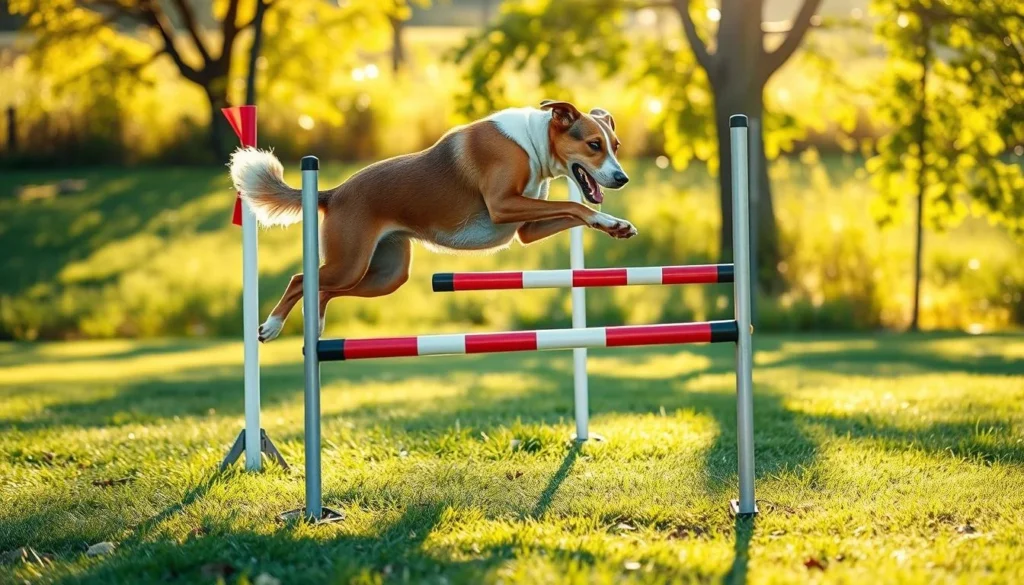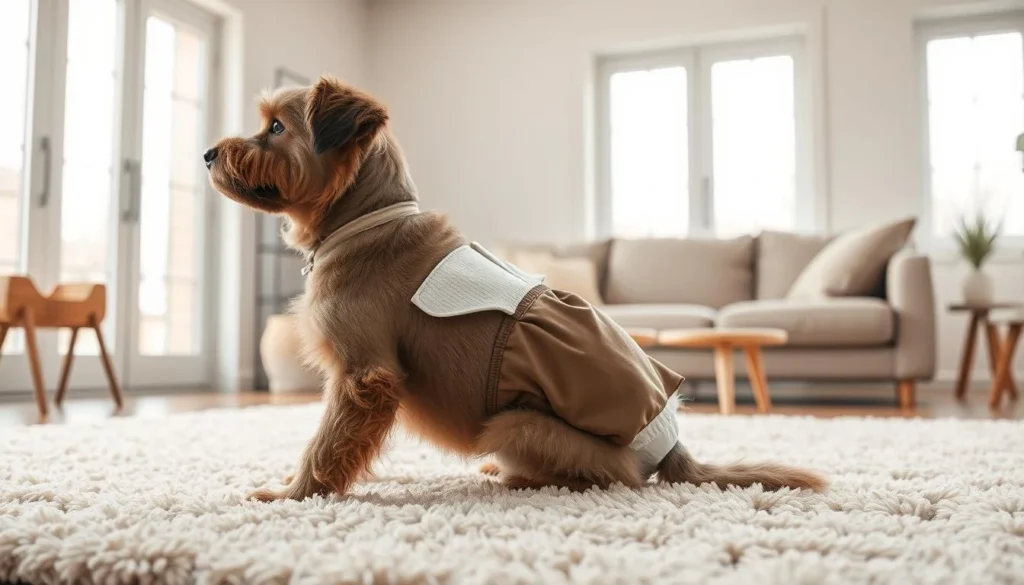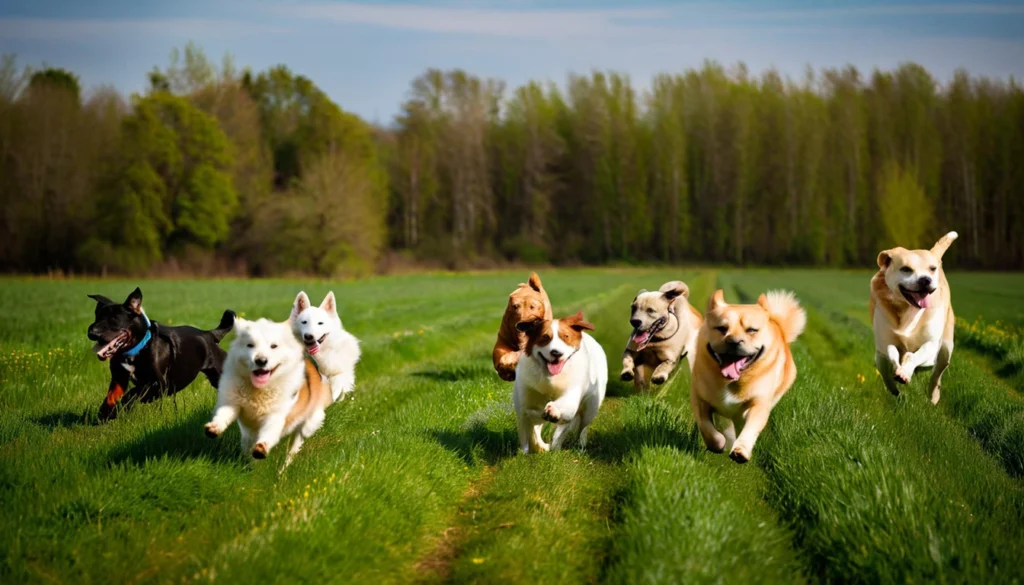As a dog owner, seeing my furry friend nibble on my hand always makes me smile. It's a behavior that puzzles me, but also fills my heart with joy. Many dog owners wonder the same thing: "Why does my dog nibble on me?"
This behavior is more than just playful. It shows their instincts and how they communicate with us. In this article, I aim to explain why dogs nibble on us. I want to help us all understand their body language and the love they show in their own special ways.
Key Takeaways
- Nibbling can be a sign of affection and bonding.
- Understanding dog body language is key to interpreting nibbling behavior.
- This behavior may stem from instinctual traits passed down through generations.
- Puppies often nibble as a natural phase during development.
- Playfulness can trigger nibbling during fun interactions.
Understanding the Nibbling Behavior in Dogs
Dogs often nibble on their owners, leaving many wondering, why does my dog keep nibbling me? This behavior is a way for dogs to show love and connect with us. It can mean they're feeling affectionate, seeking comfort, or asking for attention. To understand this, we need to interpret dog behavior and know the difference between playful nibbles and serious bites.
Nibbling is usually a sign of friendly communication, not aggression. Dogs nibble when they feel at ease, showing their natural urge to bond. This can strengthen our bond and help us understand each other better.
To understand this behavior, I've made a table with reasons why dogs nibble. Each reason shows a different emotion or need of the dog:
| Reason for Nibbling | Interpretation |
|---|---|
| Affection | Nibbling as a way of showing love and bonding. |
| Attention-Seeking | A method to gain your focus and engage in play. |
| Exploration | Using nibbling to investigate surroundings or objects. |
| Anxiety or Stress | Nibbling can manifest when a dog feels nervous or uncomfortable. |
| Instinctual Behavior | Rooted in their natural behaviors from the wild, such as grooming. |
Knowing why your dog nibbles can make your relationship better. By understanding what drives this behavior, we can make sure our dogs feel safe and happy.
Differentiating Between Nibbling and Biting
It's key for dog owners to know the difference between nibbling and biting. When my dog nibbles on my feet, it feels like play. But if they bite aggressively, it's a sign of stress or fear. Knowing this helps me interact better with my pet.
Watching my dog's body language is crucial. A relaxed dog with a wagging tail and soft eyes is just playing. But a stiff dog with a growl is showing aggression. For example, if my puppy bites during play, I redirect their energy to a toy.
By watching these signs, I can make our environment better. Understanding dog body language helps me respond right to both play and aggression. My aim is to keep our home safe and loving for my dog.
Why Does My Dog Nibble on Me?
Dogs often nibble on their owners, leading to questions like "why does my dog nibble on my nose and ears?" This behavior can show love and follow their natural instincts. Knowing why helps deepen the bond between dogs and their owners.
Affection and Bonding
Dogs show love by nibbling. It's like how puppies interact with their mothers. When my dog nibbles, it feels warm and comforting. It's a sign that I'm a source of joy.
This behavior also happens during play. It's like my puppy is playfully attacking me. But it's the most adorable thing.
Instinctual Behaviors
Some dogs nibble due to their instincts. For example, herding breeds might nibble to herd their humans. It's a sign of comfort and a nod to their past roles.
Understanding this lets me see my dog's nibbling as part of who they are. It's a way to appreciate their unique personality and background.
| Reason | Description |
|---|---|
| Affection | Nibbling to express love and create a bond. |
| Instinct | Engaging in behaviors derived from their ancestry. |
| Playfulness | Innocent nibbling during moments of joy. |
The Role of Playfulness in Nibbling
When I think about why my dog nibbles on me, playfulness comes to mind. Dogs often nibble playfully as a way to show joy. These gentle bites show they're excited, not aggressive.
Playtime is when my dog's nibbling is most obvious. He wags his tail and acts playful, wanting more fun. It's key to recognize these signs to strengthen our bond and enjoy our time together.
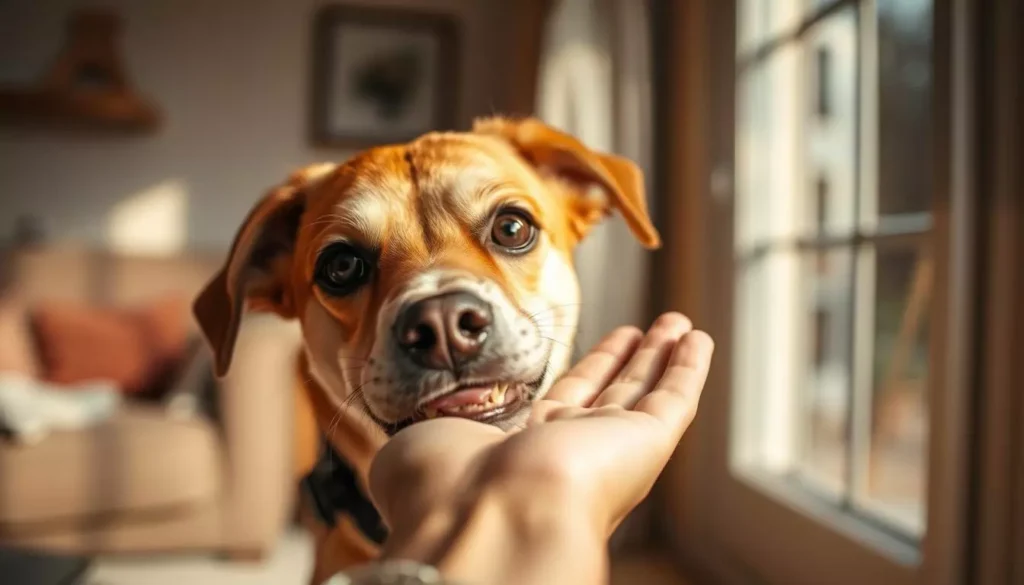
Watching my dog's body language during playful nibbling tells me a lot. It helps me understand his feelings better. Playful nibbling makes our relationship special, connecting us through joy and play.
Puppy Nibbling: A Natural Phase
Puppies love to play, and nibbling is a big part of that. Knowing why my dog nibbles my hand helps me see it as a natural part of their growth. Teething is a big reason for this behavior.
Teething and Discomfort
Teething hurts puppies, just like it does human babies. They chew and nibble to ease their sore gums. Giving them the right toys can help them feel better and keep them from chewing on things they shouldn't.
Exploration Through Nibbling
Nibbling lets puppies explore their world. They use their mouths to learn about new things. When they nibble on me, they're learning about their surroundings. Giving them safe things to chew on helps them learn and keeps them happy.
Nibbling as a Form of Communication
Dogs often nibble for more than fun. It's a key way they talk to us, showing what they need and feel. I've seen it means different things, like wanting attention or showing how they're feeling.
Attention-Seeking Behavior
My dog nibbles when they want to play or get my attention. This attention-seeking behavior happens a lot when I'm busy. It's their way of saying, "Hey, I'm here and I want to play!"
Expressing Comfort or Anxiety
Nibbling can also show how my dog feels. If they're feeling scared or unsure, nibbling is their way of saying, "I'm okay." Watching how they move helps me know if they need comfort or just want to explore.
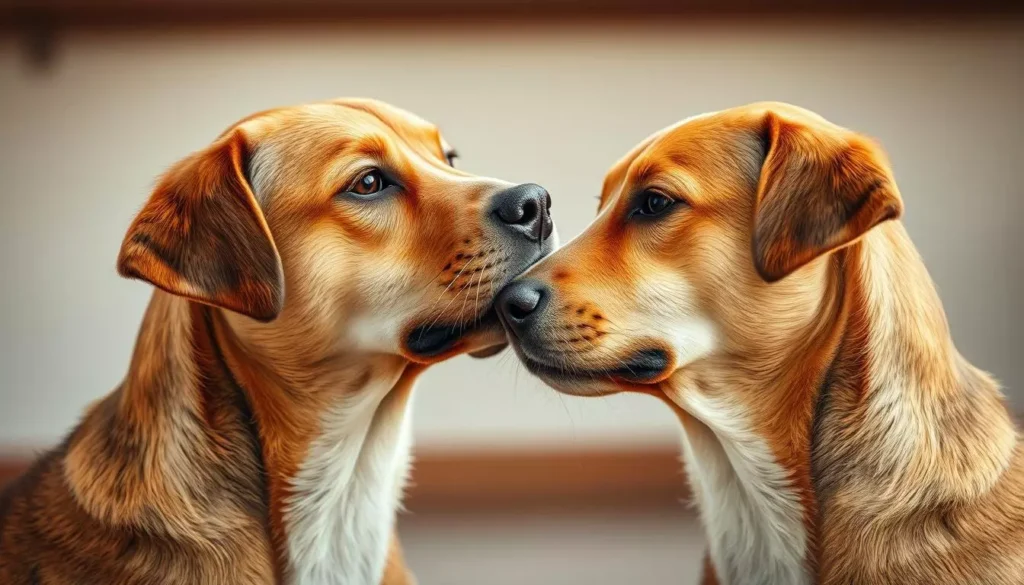
Understanding Dog Body Language
Understanding dog body language is key to figuring out why my dog nibbles. This behavior can mean anything from playfulness to discomfort. By watching my dog's posture, ear position, and facial expressions, I learn a lot about their feelings.
If my dog comes to me with relaxed ears and a wagging tail, it's usually a sign of playfulness. But, if they nibble with stiff posture or tucked ears, it might mean they're anxious or uncomfortable. Knowing how to read these signs helps me react in a way that keeps our interactions positive.
By recognizing these cues, I can make sure my dog feels safe and happy. This is important for creating a good environment for them.
| Body Language Signal | Meaning |
|---|---|
| Wagging Tail | Happy and playful |
| Tucked Ears | Anxious or scared |
| Relaxed Body | Content and comfortable |
| Stiff Posture | Defensive or uncomfortable |
Overstimulation and Discomfort: Signs to Watch For
It's important to know the signs of discomfort in dogs to have a good bond with them. Dogs show their feelings in small ways, which can look like play. It's key to notice when they might be too stressed or not feeling well.
Look out for puppy biting signs like tensing up, which means they might be anxious or need space. If my dog pulls away or doesn't want to play anymore, it's a clear sign. Knowing how dogs act helps me make sure they're comfortable. Watching for these signs keeps my dog from feeling too stressed.
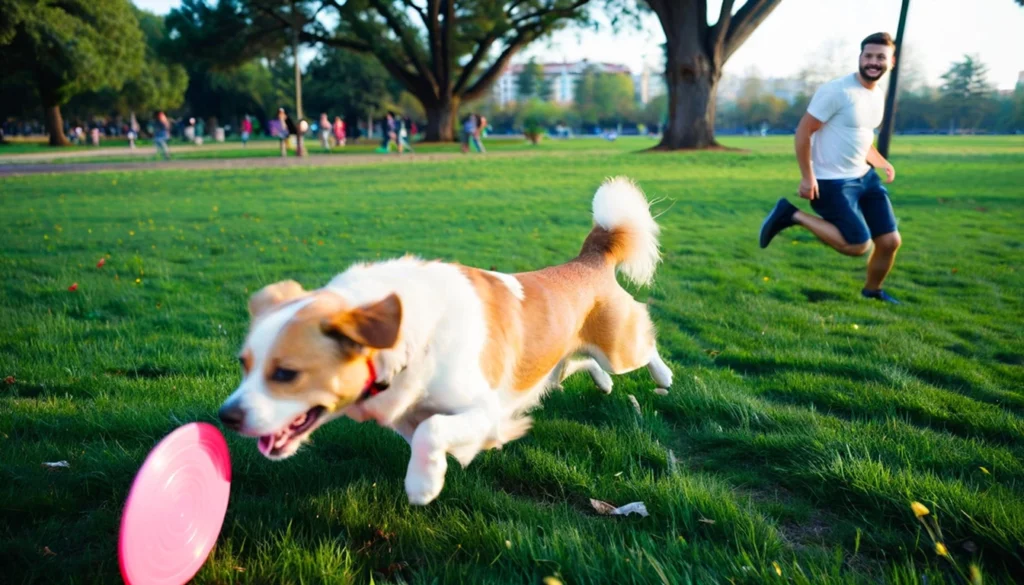
Other signs to watch for are too much panting, a tail that stops wagging, or hiding. These can mean my dog has had enough of playing. By paying attention, I can make sure we both have fun.
Addressing Nibbling Behavior in Dogs
Managing nibbling behavior is key to a good relationship with my dog. Using strategies to redirect this behavior keeps things positive. It also prevents any discomfort or misunderstandings. Giving my dog chew toys satisfies his chewing urge while keeping everyone safe.
Redirecting Attention to Chew Toys
When my dog starts nibbling on my hand or clothes, I switch his focus to chew toys. This action not only changes his focus but also encourages good chewing habits. There are many chew toys available, each appealing to different dogs.
By offering appealing toys, I manage his nibbling. This allows him to play safely and enjoyably.
Setting Boundaries for Nibbling
It's important to set clear boundaries for nibbling. I tell my dog when his nibbling is too much or uncomfortable. Stopping attention and engagement teaches him that too much nibbling is not okay.
Consistent feedback helps my dog understand what's acceptable. This makes our relationship more balanced. Setting boundaries is crucial for a harmonious life together.
Training Techniques for Addressing Dog Nibbling
Stopping dog nibbling is key to a happy pet relationship. Using positive training methods helps without scaring or upsetting my dog. I reward my dog for being gentle, not for nibbling.
When my dog nibbles, I give them chew toys instead. These toys teach them what's okay to chew. I praise them right away for choosing the toy over my hand. This shows them the good behavior gets rewards.
Being consistent is crucial. A routine helps my dog know what's expected. By always rewarding good behavior, my dog learns faster. This strengthens our bond, making my dog trust me more.
Training sessions should be fun and learning experiences. Short sessions throughout the day keep my dog interested. This makes our time together joyful and loving.
The Importance of Mental and Physical Exercise
Physical exercise is key for dogs to stop nibbling. A tired dog is happier and less likely to nibble. Activities like walks or fetch games keep my dog happy and healthy.
Mental games are also vital for my dog's happiness. Puzzle toys or scent games keep them busy and less likely to nibble. This is because they are mentally stimulated and have less energy to spare.
| Type of Exercise | Description | Benefits |
|---|---|---|
| Daily Walks | Walking around the neighborhood or a local park. | Promotes cardiovascular health and reduces anxiety. |
| Interactive Games | Games such as fetch or tug-of-war. | Enhances physical fitness and strengthens the bond between pet and owner. |
| Puzzle Toys | Toys that require problem-solving to access treats. | Stimulates mental engagement and reduces boredom. |
| Scent Trails | Creating scent trails using treats for the dog to follow. | Offers mental stimulation and encourages natural hunting instincts. |
By mixing physical and mental exercises, my dog is happier and healthier. This reduces unwanted behaviors like nibbling. It also strengthens our bond.
When to Seek Professional Help
Knowing when to get help for dog behavior is key to a good relationship with my pet. If my dog's nibbling turns aggressive, it's time to seek help. Ignoring these signs can make things worse.
Talking to a veterinary behaviorist can uncover what's behind my dog's behavior. They know a lot about animal behavior. They can tell if my dog's nibbling is part of a bigger issue.
Professional dog trainers also help a lot. They teach methods that work for my dog. This leads to better behavior.
I watch for changes in my dog's nibbling. If it hurts others or causes injury, I act fast. Also, if my dog seems scared or anxious, it's a sign of a deeper problem.
Getting help quickly helps my dog behave well. It also reduces stress for both of us.
Common Myths About Dog Nibbling
Many people have wrong ideas about why dogs nibble. They think it means aggression, but it's often just a sign of love or play. I want to clear up these myths about dog behavior and explain why dogs nibble.
Some think nibbling means a dog is angry. But usually, it's a way for dogs to show love or playfulness. Dogs have many ways to show their feelings, and nibbling is one of them.
Others believe dogs nibble because they're hungry. While it's true some dogs nibble when hungry, it's not always about food. Often, dogs nibble to explore or to get attention from their owners.
Some think if a dog nibbles, it's because they're lonely. But loneliness isn't the only reason dogs nibble. They might nibble to play or explore, not just because they're lonely.
To clear up these myths, I made a table. It shows what people think versus what's really true about dog nibbling:
| Myth | Reality |
|---|---|
| Nibbling is a sign of aggression. | Nibbling usually indicates affection or playfulness. |
| Dogs nibble when they are hungry. | Nibbling often does not correlate with hunger. |
| Nibbling means a dog is lonely. | Nibbling can stem from playfulness or exploration. |
I hope pet owners will understand these truths about dog behavior. Knowing the real reasons behind dog nibbling helps us connect better with them and meet their needs.
Conclusion
Understanding why dogs nibble helps us see their playful acts in a new light. It shows how much they care or want to talk to us. By knowing these signs, we can grow closer to our pets.
Dogs nibble for many reasons, like showing love or feeling anxious. Watching how they act helps us fix any bad habits. It also makes our home a loving place for everyone.
My goal is to build a strong bond with my dog. By listening to their signals, we can live together in peace. Learning how to handle nibbling makes our relationship even better.


